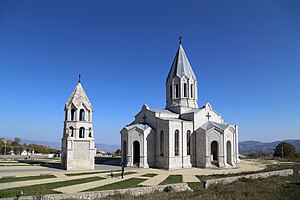Ghazanchetsots Cathedral
| Ghazanchetsots Cathedral | |
|---|---|

The cathedral in 2014
|
|
| Basic information | |
| Location | 11 Ghazanchetots St., Shusha (Shushi) de facto controlled by the Nagorno-Karabakh Republic, de jure recognized as part of Azerbaijan |
| Geographic coordinates | 39°45′32″N 46°44′52″E / 39.758819°N 46.747883°ECoordinates: 39°45′32″N 46°44′52″E / 39.758819°N 46.747883°E |
| Affiliation | Armenian Apostolic Church |
| Rite | Armenian |
| Year consecrated | September 20, 1888 June 18, 1998 |
| Status | Active |
| Architectural description | |
| Architect(s) | Simon Ter-Hakobian |
| Architectural style | Armenian |
| Groundbreaking | 1868 |
| Completed | 1887 |
| Specifications | |
| Length | 34.7 metres (114 ft) |
| Width | 23 metres (75 ft) |
| Height (max) | 35 metres (115 ft) |
The Holy Savior Cathedral (Armenian: Սուրբ Ամենափրկիչ մայր տաճար, Surb Amenap’rkich may tachar), commonly known as Ghazanchetsots Cathedral (Armenian: Ղազանչեցոց եկեղեցի, Ghazanchetsots yekeghetsi) is a major cathedral in in Shusha (Shushi), Nagorno-Karabakh. It is the seat of the Diocese of Artsakh of the Armenian Apostolic Church. It was consecrated in 1888 and is considered a landmark of entire Karabakh. It was damaged during the March 1920 massacre of Armenians of the city by Azerbaijanis and experienced a decades-long decline. During the Nagorno-Karabakh War Azerbaijan used the cathedral as an armory, where hundreds of missiles were stored. It was restored in the aftermath of the war and reconsecrated in 1998.
According to historical records a small basilica church stood on its place as of 1722. The bell tower of the cathedral was founded in 1858—10 years earlier than the church proper. The three floored bell tower was financed by the Khandamiriants family. The church's construction began in 1868 and was completed in 1887. Its name comes from Ghazanchi, a village in Nakhichevan, migrants from which financed the church's construction. It was designed by Simon Ter-Hakobian(ts). The church was consecrated on September 20, 1888 according to an inscription on upper part of the southern portal. The inscription reads:
The majority of the Armenian population of Shusha was massacred or expelled in a March 1920 massacre. The cathedral was damaged and gradually declined. It functioned until 1930. In the 1940s it was used as a granary. Its dome and part of the walls surrounding it were destroyed in 1950s. It was further looted and its stones were used to build several prestigious houses in the Azerbaijani part of the city. By the 1970s the cathedral "looked like it survived heavy shelling." Soviet and Azerbaijani authorities granted a permission to launch a restoration project of the cathedral in the 1980s under public pressure. The restoration began in 1981 and continued to till 1988 and was supervised by Volodya Babayan.
...
Wikipedia
